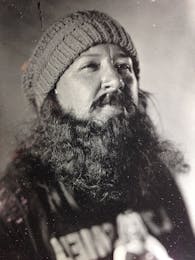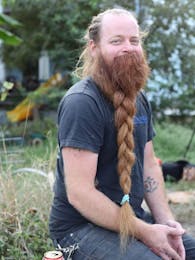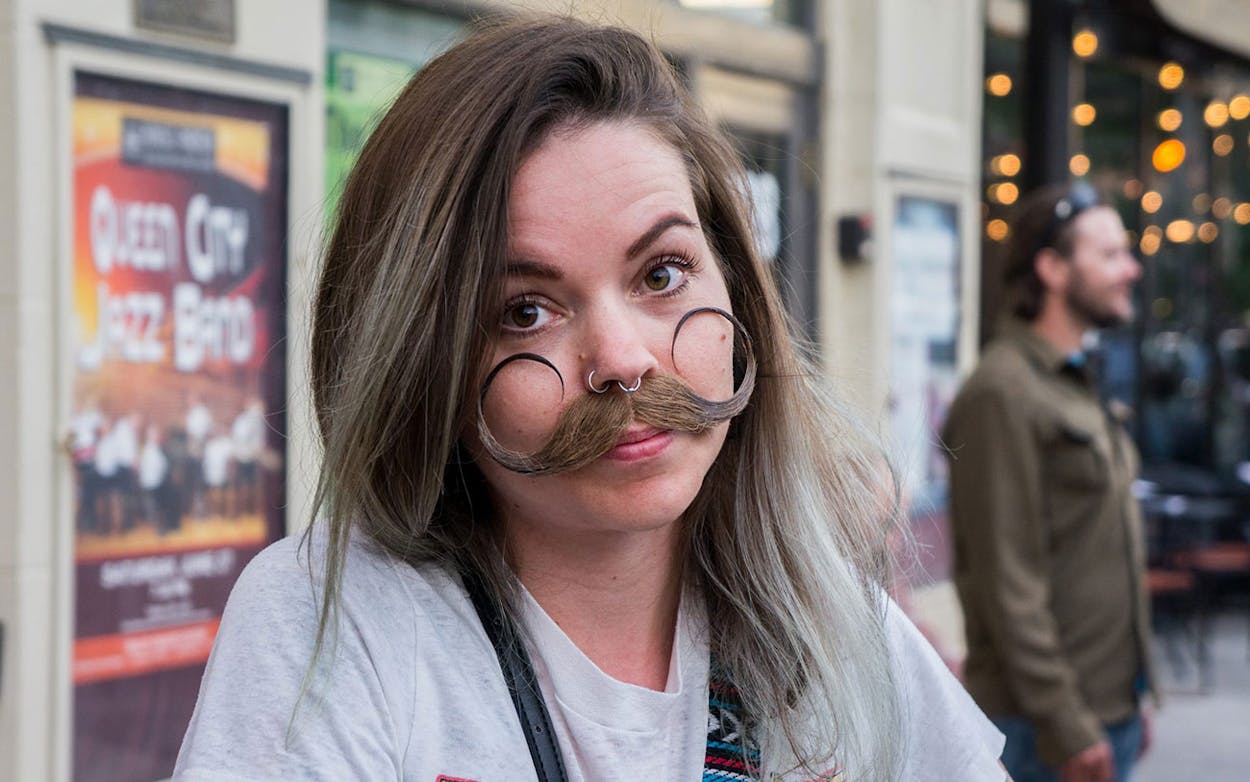A hallway cabinet in Amber Moore’s tidy South Austin home holds a trove of hirsute wonders. There’s a bright pink handlebar mustache. There’s a neatly trimmed one-piece beard-and-mustache combo—dark brown to match her hair. And in a small box labeled “3 Mustaches and a Soul Patch: No Testosterone Required!” there are varieties such as the Western, “cop-stache,” Fu Manchu, and, of course, the promised blip of fuzz that resides defiantly on the lower lip.
Although Moore, 44, purchased these and a few other facial hair items from a party supplies store, they were far from novelty for her. At around five years old, Moore grew enamored with the glorious beard and mustache belonging to her mom’s boyfriend, Barry. Somewhere along the way, though, she realized that she couldn’t grow her own. “Like, why not? No fair,” Moore laments, sitting cross-legged on her couch, with a Luckenbach t-shirt cut off at the sleeves to reveal a tattoo on each shoulder. “I’ve always had a thing for facial hair. But how do you express that?”

Her cabinet is an extension of the infatuation born in her adolescent years, but it isn’t just for Moore’s private entertainment. Moore, a special crimes detective, often sports a beard or mustache to all-female Texas Roller Derby bouts. One particular piece, a two-part beard-and-mustache set made with 75 percent synthetic hair—the other 25 percent a combination of human hair and hair from a yak—is dyed various shades of green, in homage to the Cherry Bombs, her favorite team. Moore commissioned it from Allison Lowery, a wig and makeup specialist for Texas Performing Arts at the University of Texas, who used a tool similar to a crochet hook to hand-tie between 500 and 1,000 hairs to a mesh backing. Last October, Moore wore it to the 2016 Calvello Cup, the league’s championship bout. Her effort paid off; the Cherry Bombs beat the Hellcats to win it all.
Team spirit, as it turns out, was only a bonus attribute of the eye-catching piece. Moore had the piece made to compete in the eleventh annual Come and Shave It, the Austin Facial Hair Club’s mustache and beard bacchanal.
Women with artificial facial hair, like Moore, vie for top honors in the “Realistic Mustache” and “Realistic Beard” categories, which place importance on authenticity, or the comparatively outrageous “Creative Mustache” and “Creative Beard” categories. Some of the more amazing sightings include a beard with a fishbowl containing a live fish, another constructed out of leather baseballs, and another comprised of fox and coyote pelts gathered by one woman during a hunting excursion.
Occasionally women with real facial hair compete, but don’t hold out for P.T. Barnum’s bearded ladies. Female competitive-bearding contestants typically have only slight mustaches or minor chin scruff caused by a thyroid condition. Their bravery, Austin Facial Hair Club members told me, is usually rewarded with victory.
Founded in 2007, the Austin Facial Hair Club is “open to all men and women: hirsute, in pursuit, or just generally enthused by facial hair.” Come and Shave It is the group’s cornerstone event, but it also participates in one-off affairs throughout the year, all in an effort to raise money for charity, including Caritas of Austin, the Wounded Warrior Project, Austin Animal Shelter, Austin Pets Alive, Love-A-Bull, the Inside Books Project, Out Youth, and SXSWCares. Moore belongs to a sub-group of the club called the Whiskerinas, a contingent of female facial hair advocates who have crossed into the historically male-dominated world of competitive bearding.
Tessa Bischoff, of Cincinnati, Ohio, founded the Whiskerinas after competing in her first facial hair competition in November 2010. The event was a fundraiser held in an old barn in Kettering, a suburb of Dayton, Ohio, with women’s categories consisting of about a dozen entrants. She competed alongside her husband, Matt, who was a member of Beard Team USA, one in a loose confederation of organizations across the country similar to the Austin Facial Hair Club. Bischoff, now 39, purchased a costume beard, took sections of it and braided them, and then used pins to hold up the braids at random degrees, as if to depict an octopus. She complemented the beard with a toy Viking helmet. It was good enough to place.
The competition inspired Bischoff, who saw it as an opportunity to spend more time with her husband. Men’s competitive bearding was gaining momentum, and she found that there were other wives and girlfriends who didn’t just want to watch from the sidelines. Bischoff explained her vision to her husband: she would form chapters of women across the country to hold meetings and compete together, placing a special emphasis on costumes to set themselves apart from their male counterparts.
Bischoff turned to her husband to think of a name for the group. For his beard, he took a cue from Hans Langseth, a Norwegian-American born in 1846 who held the record for the world’s longest beard, a seventeen-foot mammoth that is now an artifact in the National Museum of Natural History. She in turn discovered the story of how, in 1922, Langseth attended Days of ’49, a festival in Sacramento, California, held to celebrate the Gold Rush. There he competed with another magnificently bearded fellow named Zachary Wilcox, who was dubbed the Crown Prince of the Whiskerinos. “In my mind, I imagined a woman competing alongside them in a fake beard and being crowned a princess or queen of the Whiskerinas,” Bischoff says.
Bischoff went on to organize a couple of Whiskerinas National Ladies Fake Beard and Moustache Competitions—in 2011, in Lancaster, Pennsylvania, and in 2012, in Las Vegas, Nevada—but eventually retired from hosting. She still occasionally competes, alongside enthusiasts like Moore. For Come and Shave It, held this past February, Moore supplemented her green beard with a beanie, black boots and thick knitted socks, a kilt that she theatrically raised up to reveal boxer shorts bearing a black flag that said “penis” in pink letters, and a t-shirt promoting the album Smell the Magic, by the all-female rock band L7. Several members of the Austin Facial Hair Club said they didn’t recognize Moore until well into the competition.
“I remember some guys that just went, ugh, because they didn’t notice the breasts right off the bat,” Moore recalls. “I think they were intimidated. And then when they realized I was a Whiskerina, they were like, oh, thank God, she’s not in my category.” The effort earned Moore third place in the “Realistic Beard” category.
About a year ago, Moore was appointed a member of the Austin Facial Hair Club. There are more than fifty members, who join by paying $50 in dues, attending three meetings, and fulfilling volunteer hours. For Moore, it was more than just an opportunity to dress up. She appreciated the club’s sense of inclusivity.
“Me being gay,” Moore explains, “it’s great because most of them are married or have some female counterpart, and then here are these big, burly bearded guys walking around in their Pride shirts. That’s what really made me fall in love with the concept. It kind of helped me break out and be more myself—not that I didn’t realize who I was, but you get so used to putting up your social façade of like, okay, I’ve got to go to work now, so I’ve got to be a girl.”
The Austin Facial Hair Club was founded to fete unruly follicles of all persuasions. The club praises mustaches like the Hungarian and the Dalí. It champions partial beards like the Musketeer and the Alaskan Whaler. And it bows down to full natural beards that can grow all the way to their master’s waist. Such has been the case with Bryan Nelson, 45, a veteran of the Austin music scene and president and co-founder of the Austin Facial Hair Club, along with Allen Demling, Cory Plump, and Brent Nutting. One day, Nelson read somewhere that every man should at one point in his life grow his beard for an entire year. Nelson did that, and then he kept going and going and going—for eleven years.

Nelson’s rust-colored beard, often arranged in a three-strand braid, earned him a role, along with other Austin Facial Hair Club members, in the cable TV show Whisker Wars, which premiered in 2011 on IFC, as well as a cameo, along with his wife, Andrea, and daughter, Olympia, in the Coen Brothers’ 2010 remake of the John Wayne western True Grit. A credit in a TV series and a movie would seem to make the average beardo content, but Nelson had a serious goal: placing in the World Beard and Moustache Championships. In 2013, that mission was accomplished at the World Championships held in Leinfelden-Echterdingen, Germany, where Nelson scored second place in the “Natural Full Beard” category.
The weekend of September 1, the Austin Facial Hair Club will reach the pinnacle of competitive bearding when it hosts the 2017 World Beard and Moustache Championships at the Long Center for the Performing Arts, in Austin. The first of its kind, hosted by the First Höfener Beard Club, occurred in 1990, in Höfen/Enz, Germany, a village in the Black Forest. The championships were irregularly held in the beginning, but now typically occur every other year. This year, the Austin Facial Hair Club has registered more than 700 competitors from thirty-five countries, breaking the Guinness record of 462 competitors for a 2011 beard and mustache competition in New Hampshire. This is the third Worlds to take place in the U.S. and the first in Texas.
This will also be the first Worlds in history to host a Whiskerinas competition. More than sixty women are confirmed. The integration of a female contest was met with indifference among the old school Europeans, who are accustomed to male-only contests. But female competitors have long been a part of Come and Shave Its. “When we brought it up, there was a big discussion about it at the World Beard and Moustache Association meeting,” Nelson says. “People were like, how does that make sense? I don’t understand. What’s next, people putting beards on their pets? We’re like, no, it’s a thing.”
On a Sunday afternoon in late June, I attended an Austin Facial Hair Club meeting at Rio Rita, a bar in East Austin. A couple dozen members and wannabes congregated outside on the patio, with males outnumbering females roughly three to one. Lone Star tallboys, Bloody Marys, and Topo Chicos littered the tables arranged haphazardly to glean shade from scant umbrellas. T-shirts—most bearing the club logo, a skull with a beard—were seeped through with sweat from the sweltering heat. Imagine what it was like under all of that facial hair.
Drawing from a small notebook, Nelson went over the club’s upcoming affairs. There was a male pudding-wrestling event, as well as Dickens on the Strand, a Christmas gathering in Galveston where people dress as Charles Dickens characters from Victorian-era London. But the main point of business was Worlds.
Nelson didn’t so much direct the meeting as he did look to others for updates. With the majority of his face covered in beard, red sunglasses, and a neon-orange camouflage ball cap turned backwards, he was like an eccentric poker player unwilling to tip his hand. The main person in charge, it seemed, was Jessica Ives, a 31-year-old tech worker with a pair of sleeve tattoos and a nose ring. Nelson and others deferred questions to her. Around 2010, Ives met some members of the club at an Austin bar and bonded over the shared experience of having previously worked at The County Line, a local barbecue joint. She started dating one of the members, who is no longer with the club, and got heavily involved in their proceedings, first as a Whiskerina and now as the manager of logistics.
Once the meeting was over, after about thirty minutes, I gathered at a table inside Rio Rita with Ives and a handful of other Whiskerinas to hear their stories. Ives said she was first exposed to competitive bearding as a contestant in the inaugural Whiskerinas National Ladies Fake Beard and Moustache Competition. For that contest, she wore her “Nelson beard,” in homage to Bryan Nelson, a “creative” entry that she made by latch-hooking super-long strands of multi-colored yarn to an elastic band that she mounted to her head. Laced through the yarn were beads with skulls on them depicting the Austin Facial Hair Club logo. It took her sixteen hours over a couple of months to construct the piece. It wasn’t enough to place in the top three.
A couple of years later, Ives was set to compete in Houston. It was the eleventh hour and she hadn’t settled on what she was going to wear. Suddenly, she envisioned Jackie Lynn Ellison, an Austin Facial Hair Club member who won first place at the 2015 Worlds for his “imperial mustache,” a small, bushy style with tips arching upwards. Ellison was living in Houston at the time, and his club was organizing the event. “My hair is naturally kind of wavy and does those big curls throughout it so I just chopped off the curliest ones I could find in the back of my head the morning of the competition and then got some Got2b Glued spray and just glued it all together,” Ives says. She won first in “realistic,” as well as Best in Show.
Ives doesn’t compete any longer, but she still dresses the part when she’s working an event because she enjoys the compliments she gets from females and males alike. “When I wear my mustache and I make my boyfriend give me kisses, he’s like, ‘This is so weird,’” she says. “‘And I’m okay with it.’”

Angela Alba-DiRico, a 39-year-old gemologist, is the Whiskerina many of the others hailed as a serious contender at Worlds. Alba-DiRico is married to the club’s merchandise manager, Tony DiRico. The two of them befriended Nelson around 2000, when they all hung out at the Austin music club Flamingo Cantina. In the fall of 2015, Alba-DiRico was manning her jewelry booth at the East Austin Studio Tour when a female customer, aware of Alba-DiRico’s affiliation with the club, asked Alba-DiRico if she could create a beard for her by braiding her hair and then draping it around the front of her face.
“She braids one for me and a picture gets snapped,” Alba-DiRico recounts. A few weeks later, that photo, along with photos of other ladies with fake beards, appeared on the website Bored Panda, where visitors could vote on their favorite. “It was bizarre and strange and that’s kind of how I got thrust into all of it,” Alba-DiRico admits.
For Alba-DiRico and Ives, and many of the other Whiskerinas, this manner of show is purely for fun, but for Moore it’s something bigger. Moore is far more likely to beard out in public, at affairs unrelated to the Austin Facial Hair Club. Take, for instance, the roller derby bout she was prepping for, between the Rhinestone Cowgirls and Putas Del Fuego, when I visited her in July.
As Moore put the finishing touches on her “outlaw country” character—black cowboy hat, cowboy boots, sunglasses, a belt buckle with the letter “A” on it—she expounded on the struggle she’s had coming to terms with her identity. “When I was coming out as gay,” she says, “it occurred to me—this will sound silly—I was like, well, I’m a woman, and I like women, so I’m a lesbian. That’s the check-off box that society has put out there. And then after I joined the facial hair club, I thought to myself, wait a minute, what if I’m actually a straight man trapped in a women’s body and that’s why I like women?”
The roller derby bout took place at the Palmer Events Center. In the middle of the arena was a banked track where Dusty Doublewide of the Rhinestone Cowgirls leveled players with her body blows and Smitey Mouse of Putas Del Fuego darted through masses of players en route to putting points on the board for her team. On the periphery of the track an older man dressed in a Wonder Woman outfit skated around, inciting yips and yelps from the hundreds of adults and children in attendance. The play-by-play of announcers filled the air. Several Austin Facial Hair Club members were there—they erect the track, a favor returned in kind by the roller derby players through their support of club events.
From afar, Moore looked like a man just nursing a cold beer and enjoying watching ladies smack each other around. But up close, her curves amplified, it was obvious she was a female. As she walked through the arena, caressing and tugging at her chin like a man with a hefty beard, I noticed one middle-aged woman in the audience quickly size her up and under her breath to her husband say, “Oh wow.” Other than that, Moore seemed to fit right in. In this increasingly crazy world, it takes a lot to faze people. Androgyny ain’t no thing.
“I think the facial hair club kind of helped me embrace more of like, maybe am I gender-fluid,” Moore contemplates. “I don’t consider myself transgender. I have no desire to have surgery and take hormones and grow a real beard or anything like that. I love being a woman. You can call me ‘her.’ I’m not changing any of that. But I feel like I ebb and flow, just like a liquid. I can be really feminine at one point or I can just totally dude it up.”
Moore continued to make the rounds, surprising friends who didn’t immediately recognize her. She talked excitedly about Worlds and the beard and mustache Lowery was making her, constructed one hundred percent of real hair. Would it guarantee her victory? Perhaps she’s already won.






